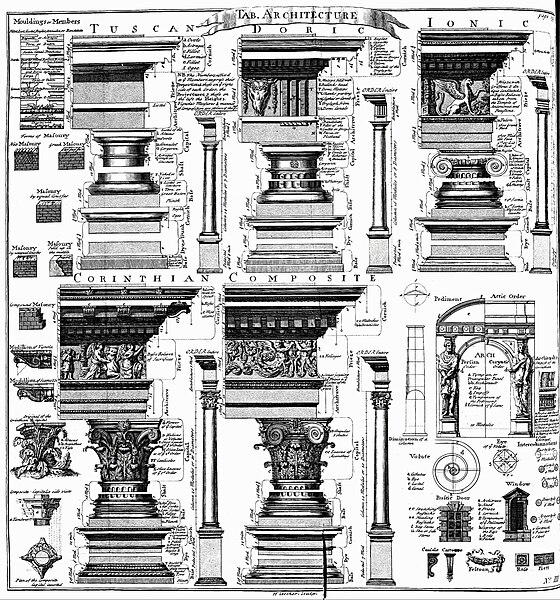The Composite order is a mixed order, combining the volutes of the Ionic order capital with the acanthus leaves of the Corinthian order. In many versions the composite order volutes are larger, however, and there is generally some ornament placed centrally between the volutes. The column of the composite order is typically ten diameters high, though as with all the orders these details may be adjusted by the architect for particular buildings. The Composite order is essentially treated as Corinthian except for the capital, with no consistent differences to that above or below the capital.
Illustration of the Composite order, made in 1695 and kept in Deutsche Fotothek
The Five Orders illustrated by Vignola, 1641
Unlike the Composite capital, this Ionic capital has a different appearance from the front and sides
Roman Composite columns of the Library of Celsus, Ephesus, Turkey, unknown architect, c.110 AD
An order in architecture is a certain assemblage of parts subject to uniform established proportions, regulated by the office that each part has to perform.
Coming down to the present from Ancient Greek and Ancient Roman civilization, the architectural orders are the styles of classical architecture, each distinguished by its proportions and characteristic profiles and details, and most readily recognizable by the type of column employed. The three orders of architecture—the Doric, Ionic, and Corinthian—originated in Greece. To these the Romans added, in practice if not in name, the Tuscan, which they made simpler than Doric, and the Composite, which was more ornamental than the Corinthian. The architectural order of a classical building is akin to the mode or key of classical music; the grammar or rhetoric of a written composition. It is established by certain modules like the intervals of music, and it raises certain expectations in an audience attuned to its language.

Illustrations of the Classical orders (from left to right): Tuscan, Doric, Ionic, Corinthian and Composite, made in 1728, from Cyclopædia
Greek orders with full height
Doric capital of the Parthenon from Athens
Ionic capital from the Queen Elizabeth II Great Court of the British Museum (London)








